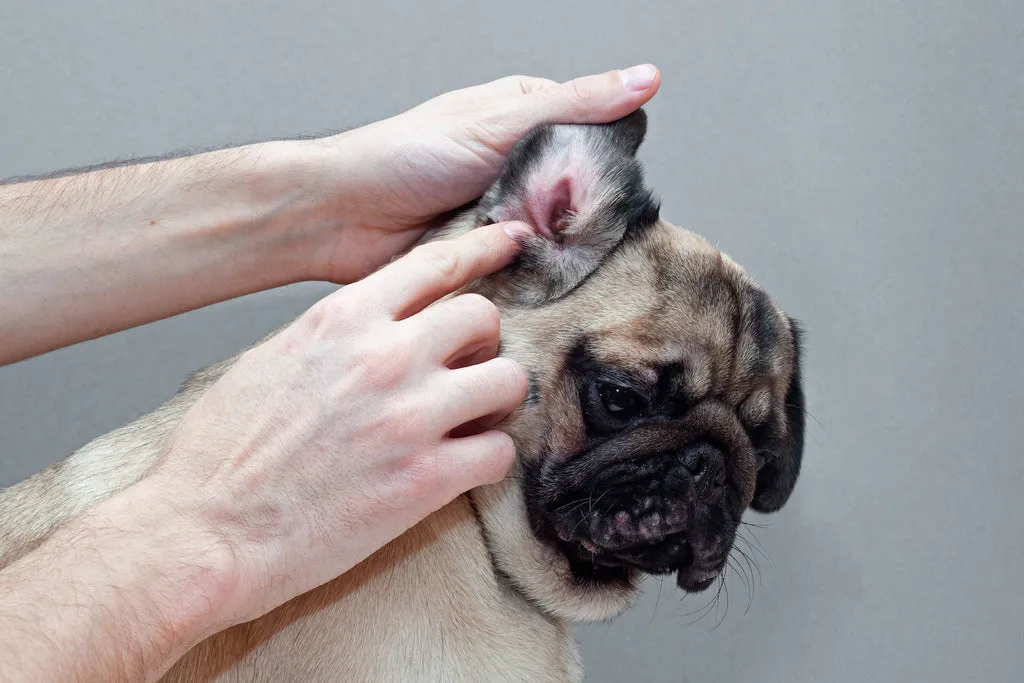Itchiness, persistent scratching, and hair loss are common and distressing problems for dogs, often leaving pet parents searching for immediate solutions. While various conditions can cause these symptoms, mites are a frequent culprit, leading to discomfort and potentially more severe skin issues. Understanding the different types of mites and available treatment options, including what can be managed with over-the-counter (OTC) products and when professional veterinary care is essential, is key to restoring your dog’s comfort and health. This guide will delve into the world of dog mites, highlight recognizable symptoms, and outline effective strategies for prevention and treatment, with a focus on accessible over-the-counter remedies and crucial vet intervention.
Understanding Dog Mites and Their Impact
Mites are not insects but tiny arthropods, closely related to spiders, that can infest your dog’s skin and ears. These microscopic parasites can cause significant irritation, leading to conditions collectively known as mange. Different mite species present unique challenges and symptoms, making accurate identification by a veterinarian critical for effective treatment. While severe infestations almost always require prescription medication, some over-the-counter products can provide relief for mild symptoms or support veterinary-prescribed treatments.
Demodex Canis Mites
Demodex mites are naturally present on most dogs in small numbers without causing issues. However, in dogs with compromised immune systems, particularly puppies, neglected animals, or those with poor diets, these mites can proliferate, leading to a condition called demodicosis, or demodectic mange. This infestation targets hair follicles, resulting in hair loss, thickened skin, and often secondary bacterial or yeast infections. While some milder, localized cases in puppies may resolve on their own, generalized demodicosis typically requires veterinary diagnosis through skin scrapings and prescription medications such as afoxolaner, fluralaner, lotilaner, or sarolaner. Some veterinarians might recommend a lime-sulfur dip as part of the treatment, which can be administered at home under strict vet guidance.
Sarcoptes Scabiei Mites
Sarcoptes scabiei mites are far more insidious, burrowing into a dog’s skin and causing intense, relentless itching. This highly contagious condition, known as sarcoptic mange or canine scabies, can spread rapidly between dogs and even to humans, causing a temporary rash. Symptoms often include severe scratching, especially around the armpits and groin, accompanied by redness and hair loss. Diagnosis usually involves a vet examining skin scrapings. Effective treatment for sarcoptic mange almost always requires prescription medications, such as heartworm medication containing ivermectin or other medications like imidacloprid or moxidectin. There are no truly effective over-the-counter “cures” for sarcoptic mange, though some medicated shampoos can provide temporary symptomatic relief.
Otodectes Cynotis Mites (Ear Mites)
Ear mites are highly common, particularly in puppies and dogs who interact with outdoor cats. These surface mites live within the ear canal, causing profound itchiness. Signs of ear mites include constant scratching at the ears, excessive head shaking that can lead to broken blood vessels, and the presence of dark, crumbly “dirt” resembling coffee grounds inside the ear flaps. While these symptoms can also indicate a bacterial or yeast ear infection, a vet can quickly diagnose ear mites using an otoscope. For ear mites, prescription ear drops are the most effective treatment. However, over-the-counter ear cleaners can be beneficial for routine hygiene and may help flush out some mites or debris, but they are not a standalone cure for an active infestation.
Cheyletiella Yasguri Mites (Walking Dandruff)
Cheyletiella mites cause cheyletiellosis, colloquially known as “walking dandruff” because the mites and skin flakes they cause can resemble moving dandruff. This infestation leads to generalized itchiness and flaky skin. A veterinarian can identify these mites under a microscope from skin or hair samples. Treatment often involves prescription medications like selamectin, administered over several weeks to target all life cycles of the mite. Pyrethrin shampoos, which can be found over the counter, are sometimes recommended as an adjunctive treatment to help kill surface mites and alleviate symptoms, but they are typically not sufficient on their own to eradicate the infestation.
 Dogs playing together in a field, showing potential for mite transmission
Dogs playing together in a field, showing potential for mite transmission
Recognizing Symptoms of Mite Infestation
Regardless of the specific mite type, several common symptoms indicate a potential infestation. While these signs can also be caused by other conditions like allergies or hot spots, they warrant immediate attention and often a vet visit. Early recognition is crucial for swift treatment.
Common symptoms include:
- Intense and persistent itching: This is the most prevalent sign, with dogs often scratching, licking, or biting affected areas excessively.
- Raw, red, or inflamed skin: Constant scratching can lead to irritation and open sores.
- Crusty patches of skin: Especially noticeable in sarcoptic mange, where mites burrow and cause lesions.
- Hair loss (alopecia): Often seen in patches, particularly around the eyes, muzzle, ears, and limbs, or generalized thinning of the coat.
- Dandruff or flaky skin: In the case of Cheyletiella mites, this may appear to be “walking” dandruff.
- Dark “dirt” in the ears: A characteristic sign of ear mites, resembling coffee grounds.
- Secondary infections: Due to broken skin from scratching, bacterial or fungal infections can develop, leading to further irritation, odor, and pain.
If you observe any of these symptoms, it’s vital to consult your veterinarian for an accurate diagnosis and to rule out other skin conditions.
 A dog scratching intently due to skin irritation, possibly from mites
A dog scratching intently due to skin irritation, possibly from mites
Over-the-Counter Solutions for Dog Mite Relief and Prevention
While a confirmed mite infestation generally requires a veterinarian’s diagnosis and prescription medication, several over-the-counter products and home care strategies can support your dog’s skin health, alleviate mild symptoms, and play a crucial role in preventing infestations or re-infestations. These options are best used in conjunction with professional advice, rather than as standalone cures for active cases.
Medicated Shampoos and Dips
For surface mites like Cheyletiella, or to provide symptomatic relief for other types of mange, medicated shampoos containing ingredients like pyrethrin, sulfur, or benzoyl peroxide can be helpful. Lime-sulfur dips, although often vet-prescribed, can sometimes be purchased over the counter and used at home for various mite types, but always follow your vet’s specific instructions for dilution and application. These products can help wash away mites and dead skin, soothe irritated skin, and reduce secondary infections. However, they typically do not penetrate the skin deeply enough to eliminate burrowing mites like Sarcoptes.
Ear Cleaners for Ear Mites
For ear mites, over-the-counter ear cleaning solutions can help remove wax and debris, making the ear less hospitable for mites and potentially flushing out some surface mites. These are excellent for routine ear hygiene and can relieve minor irritation. However, they are not formulated to kill ear mites effectively and should not replace prescription ear drops for an active infection. If your dog suffers from a urinary tract infection, there are also over-the-counter UTI medications for dogs that focus on symptom relief, similar to how ear cleaners function for mites – supportive care, not a cure.
Supplements for Skin and Immune Health
A strong immune system is a dog’s best defense against many health issues, including parasitic infestations. Research suggests that a robust immune response can reduce the risk of demodectic mange. Incorporating supplements that support skin and immune health can be a valuable part of a holistic prevention strategy.
- Probiotics: High-quality probiotic supplements can promote a healthy gut, which is intrinsically linked to immune function and overall well-being. Look for dog-specific probiotics with multiple strains, digestive enzymes, and added nutrients from superfoods like blueberry and pumpkin. Avoid human-grade probiotics or those with artificial flavors, preservatives, or fillers like wheat or corn. For example, some wet dog food with probiotics can offer these benefits as part of their daily diet.
- Omega-3 Fatty Acids: Supplements rich in omega-3 fatty acids (like fish oil) are renowned for their anti-inflammatory properties and ability to support healthy skin and a shiny coat. This can strengthen the skin’s barrier function, making it less susceptible to irritations and infestations.
Environmental Control and Grooming
Consistent hygiene and grooming are crucial for both prevention and treatment support:
- Regular Grooming: Brushing your dog regularly allows you to inspect their skin and coat for any abnormalities, catching potential mite issues early. Use pet-friendly shampoos that are gentle on their skin.
- Bedding Hygiene: Mites, eggs, and larvae can linger in your dog’s environment. Regularly laundering your pet’s bedding in hot water helps eliminate parasites and prevents re-infestation.
- Post-Boarding Baths: If your dog stays at a kennel or interacts frequently with other animals, consider bathing them soon after to wash away any potential hitchhikers.
 Close-up of a dog's skin showing irritation or redness, possibly from mites causing severe itching
Close-up of a dog's skin showing irritation or redness, possibly from mites causing severe itching
When to See Your Veterinarian
While over-the-counter options can provide supportive care and relief for minor symptoms, they are rarely sufficient to cure an active, diagnosed mite infestation, especially for burrowing mites or widespread mange. It is paramount to consult your veterinarian if you suspect your dog has mites.
A vet can:
- Accurately Diagnose: Through skin scrapings, ear swabs, or other diagnostic tests, your vet can identify the exact type of mite and rule out other conditions. This precision ensures the correct treatment protocol.
- Prescribe Effective Medications: Many mite infestations require prescription-strength parasiticides, either oral, topical, or injectable, that are not available over the counter. These medications are specifically formulated to kill mites at various life stages and often work more quickly and thoroughly than OTC options.
- Address Secondary Infections: If your dog has developed bacterial or fungal infections due to scratching, your vet can prescribe antibiotics or antifungals to treat these complications.
- Monitor Progress: Your vet can schedule follow-up appointments and repeat diagnostic tests to ensure the mites are completely eradicated, preventing recurrence.
Ignoring mite symptoms or solely relying on over-the-counter remedies without a proper diagnosis can prolong your dog’s suffering, lead to more severe skin damage, and make the condition harder to treat in the long run.
Conclusion
Dealing with dog mites can be challenging, but understanding the types of mites, recognizing their symptoms, and knowing your treatment options are crucial steps toward helping your beloved companion. While a range of over-the-counter products like medicated shampoos, ear cleaners, and immune-boosting supplements can offer relief and support prevention, it’s essential to remember that most active mite infestations require the professional diagnosis and prescription-strength treatments only a veterinarian can provide. Prioritizing your dog’s health means being proactive with prevention, observant of symptoms, and always seeking veterinary guidance for suspected mite issues. With timely and appropriate care, your dog can quickly return to a happy, itch-free life.
